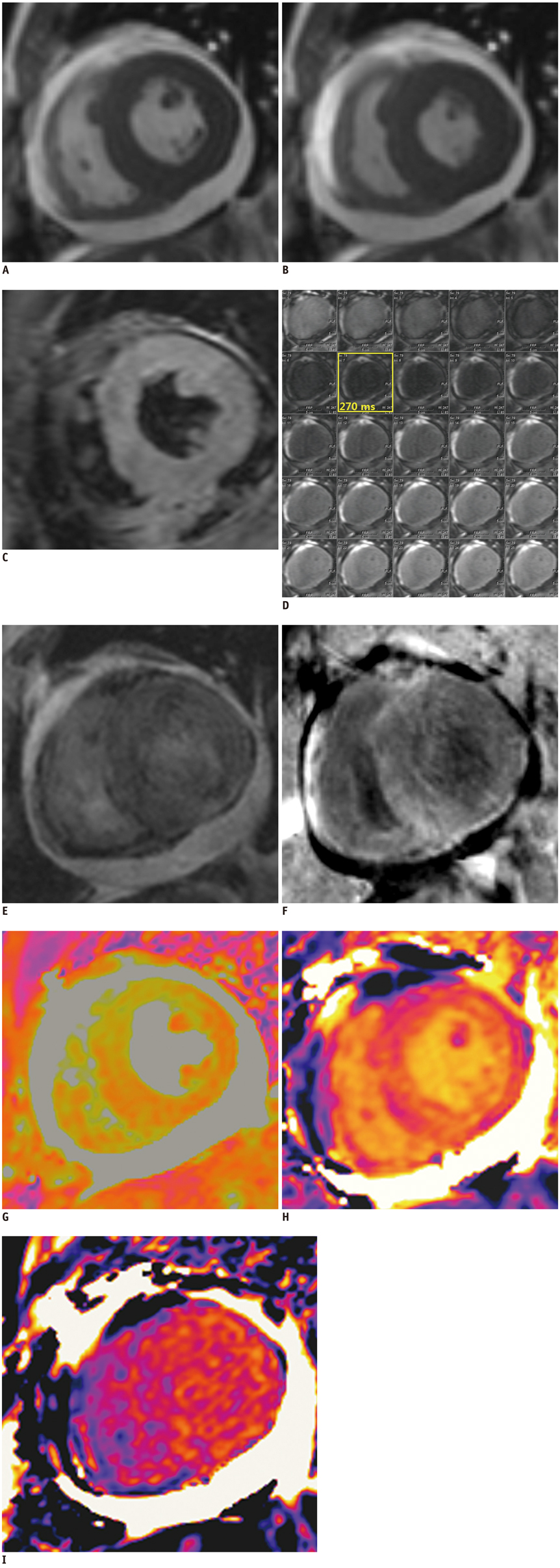Korean J Radiol.
2013 Oct;14(5):727-732. 10.3348/kjr.2013.14.5.727.
Diagnosis of Acute Global Myocarditis Using Cardiac MRI with Quantitative T1 and T2 Mapping: Case Report and Literature Review
- Affiliations
-
- 1Department of Radiology and Research Institute of Radiological Science, Yonsei University Health System, Seoul 135-720, Korea. thkim1@yuhs.ac
- 2Division of Cardiology, Department of Internal Medicine, Gangnam Severance Hospital, Yonsei University College of Medicine, Seoul 135-720, Korea.
- 3Healthcare Sector, Siemens AG, Erlangen D-91052, Germany.
- 4Siemens Ltd., Seoul 120-837, Korea.
- KMID: 1711426
- DOI: http://doi.org/10.3348/kjr.2013.14.5.727
Abstract
- The diagnosis of myocarditis can be challenging given that symptoms, clinical exam findings, electrocardiogram results, biomarkers, and echocardiogram results are often non-specific. Endocardial biopsy is an established method for diagnosing myocarditis, but carries the risk of complications and false negative results. Cardiac magnetic resonance imaging (MRI) has become the primary non-invasive imaging tool in patients with suspected myocarditis. Myocarditis can be diagnosed by using three tissue markers including edema, hyperemia/capillary leak, and necrosis/fibrosis. The interpretation of cardiac MR findings can be confusing, especially when the myocardium is diffusely involved. Using T1 and T2 maps, the diagnosis of myocarditis can be made even in cases of global myocarditis with the help of quantitative analysis. We herein describe a case of acute global myocarditis which was diagnosed by using quantitative T1 and T2 mapping.
Keyword
MeSH Terms
Figure
Reference
-
1. Blauwet LA, Cooper LT. Myocarditis. Prog Cardiovasc Dis. 2010; 52:274–288.2. Friedrich MG, Sechtem U, Schulz-Menger J, Holmvang G, Alakija P, Cooper LT, et al. Cardiovascular magnetic resonance in myocarditis: A JACC White Paper. J Am Coll Cardiol. 2009; 53:1475–1487.3. Feldman AM, McNamara D. Myocarditis. N Engl J Med. 2000; 343:1388–1398.4. Laissy JP, Messin B, Varenne O, Iung B, Karila-Cohen D, Schouman-Claeys E, et al. MRI of acute myocarditis: a comprehensive approach based on various imaging sequences. Chest. 2002; 122:1638–1648.5. Cerqueira MD, Weissman NJ, Dilsizian V, Jacobs AK, Kaul S, Laskey WK, et al. Standardized myocardial segmentation and nomenclature for tomographic imaging of the heart. A statement for healthcare professionals from the Cardiac Imaging Committee of the Council on Clinical Cardiology of the American Heart Association. Int J Cardiovasc Imaging. 2002; 18:539–542.6. Verhaert D, Thavendiranathan P, Giri S, Mihai G, Rajagopalan S, Simonetti OP, et al. Direct T2 quantification of myocardial edema in acute ischemic injury. JACC Cardiovasc Imaging. 2011; 4:269–278.7. Nacif MS, Turkbey EB, Gai N, Nazarian S, van der Geest RJ, Noureldin RA, et al. Myocardial T1 mapping with MRI: comparison of look-locker and MOLLI sequences. J Magn Reson Imaging. 2011; 34:1367–1373.8. Ugander M, Oki AJ, Hsu LY, Kellman P, Greiser A, Aletras AH, et al. Extracellular volume imaging by magnetic resonance imaging provides insights into overt and sub-clinical myocardial pathology. Eur Heart J. 2012; 33:1268–1278.9. Gutberlet M, Spors B, Thoma T, Bertram H, Denecke T, Felix R, et al. Suspected chronic myocarditis at cardiac MR: diagnostic accuracy and association with immunohistologically detected inflammation and viral persistence. Radiology. 2008; 246:401–409.10. Giri S, Chung YC, Merchant A, Mihai G, Rajagopalan S, Raman SV, et al. T2 quantification for improved detection of myocardial edema. J Cardiovasc Magn Reson. 2009; 11:56.11. Ugander M, Bagi PS, Oki AJ, Chen B, Hsu LY, Aletras AH, et al. Myocardial edema as detected by pre-contrast T1 and T2 CMR delineates area at risk associated with acute myocardial infarction. JACC Cardiovasc Imaging. 2012; 5:596–603.12. Maceira AM, Joshi J, Prasad SK, Moon JC, Perugini E, Harding I, et al. Cardiovascular magnetic resonance in cardiac amyloidosis. Circulation. 2005; 111:186–193.
- Full Text Links
- Actions
-
Cited
- CITED
-
- Close
- Share
- Similar articles
-
- Native T1 Mapping Demonstrating Apical Thrombi in Eosinophilic Myocarditis Associated with Churg-Strauss Syndrome
- Clinical Application of T1 and T2 Mapping in Cardiac Magnetic Resonance Imaging for Nonischemic Cardiomyopathy: A Case-Based Review
- Treatment Response Evaluation of Cardiac Amyloidosis Using Serial T1- and T2-Mapping Cardiovascular Magnetic Resonance Imaging
- Regional Amyloid Burden Differences Evaluated Using Quantitative Cardiac MRI in Patients with Cardiac Amyloidosis
- CMR Parametric Mapping as a Tool for Myocardial Tissue Characterization


